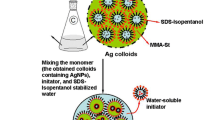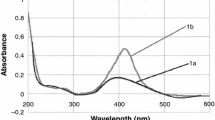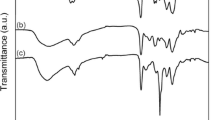Abstract
Silver nanoparticles (Ag NPs) coated by an aqueous emulsion of copolymer were elaborated in a short time using polyol process and microwave (MW) heating. This approach is based on reducing AgNO3 powder in the presence of two main components; ethylene glycol as a dispersed medium and an industrial copolymer (latex) as protecting agent. The structural, morphological and optical properties of the prepared silver nanoparticles have been investigated by UV–Vis spectroscopy, Infrared Spectroscopy (IR), X Ray Diffraction (XRD) and Transmission Electron Microscopy (TEM). It was found that all these properties are strongly correlated to the latex copolymer concentration and the MW heating process. The absorption band was determined by UV Visible spectra, showing several bands (localized surface Plasmon band) in the visible region at wavelengths between 410 and 430 nm. The TEM analysis of the obtained products indicates the presence of straight nanowires and dispersed, spherical silver nanoparticles with well-controlled size ranging from 7 to 20 nm. The X Ray Diffraction showed that silver nanoparticles synthesized exhibit face centered cubic (fcc) structure. The infrared spectra show the strong coordination between the surface of silver particles and molecules of latex by O–H and C=O groups. Antimicrobial activity of latex/Ag NPs against E. coli, Staphylococcus aureus, and Pseudomonas aeruginosa has been also demonstrated. The results indicated that latex/AgNPs may damage the structure of bacterial cell membrane.









Similar content being viewed by others
References
A. Syafiuddin, M. R. Salim, A. Beng Hong Kueh, T. Hadibarata, and H. Nur (2017). A review of silver nanoparticles: research trends, global consumption, synthesis, properties, and future challenges. J. Chin. Chem. Soc. 64, 732–756.
A. Kumar, P. K. Vemula, P. M. Ajayan, and G. John (2008). Silver-nanoparticle-embedded antimicrobial paints based on vegetable oil. Nat. Mater. 7, 236–241.
A. Desireddy, B. E. Conn, J. Guo, B. Yoon, R. N. Barnett, B. M. Monahan, K. Kirschbaum, W. P. Griffith, R. L. Whetten, and U. Landman (2013). Ultrastable silver nanoparticles. Nature 501, 399–402.
Y. Sun and Y. Xia (2002). Shape-controlled synthesis of gold and silver nanoparticles. Science 298, 2176–2179.
H. A. Atwater and A. Polman (2011). Plasmonics for improved photovoltaic devices. Nat. Mater. 9, 205–213.
W.-R. Li, X.-B. Xie, Q.-S. Shi, H.-Y. Zeng, Y.-S. Ou-Yang, and Y.-B. Chen (2010). Antibacterial activity and mechanism of silver nanoparticles on Escherichia coli. Appl. Microbiol. Biotechnol. 85, 1115–1122.
C. Li, Y. Zhang, M. Wang, Y. Zhang, G. Chen, L. Li, D. Wu, and Q. Wang (2014). In vivo real-time visualization of tissue blood flow and angiogenesis using Ag2S quantum dots in the NIR-II window. Biomaterials 35, 393–400.
I. Sondi and B. Salopek-Sondi (2004). Silver nanoparticles as antimicrobial agent: a case study on E. coli as a model for Gram-negative bacteria. J. Colloid Interface Sci. 275, 177–182.
S. Hirano, Y. Wakasa, A. Saka, S. Yoshizawa, Y. Oya-Seimiya, Y. Hishinuma, A. Nishimura, A. Matsumoto, and H. Kumakura (2003). Preparation of Bi-2223 bulk composed with silver-alloy wire. Physica C 392, 458–462.
Z.-Y. Hong, H.-Y. Feng, and L.-H. Bu (2020). Melanin-based nanomaterials: The promising nanoplatforms for cancer diagnosis and therapy. Nanomed. Nanotechnol. Biol. Med. 28, 102211.
G. Vares, V. Jallet, Y. Matsumoto, C. Rentier, K. Takayama, T. Sasaki, Y. Hayashi, H. Kumada, and H. Sugawara (2020). Functionalized mesoporous silica nanoparticles for innovative boron-neutron capture therapy of resistant cancers. Nanomed. Nanotechnol. Biol. Med. 27, 102195.
M. M. Khan, A. Madni, N. Filipczak, J. Pan, M. Rehman, N. Rai, S. A. Attia, and V. P. Torchilin (2020). Folate targeted lipid chitosan hybrid nanoparticles for enhanced anti-tumor efficacy. Nanomed. Nanotechnol. Biol. Med. 28, 102228.
A. N. Shipway, M. Lahav, and I. Willner (2000). Nanostructured gold colloid electrodes. Adv. Mater. 12, 993–998.
H. Jiang, S. Manolache, A. C. L. Wong, and F. S. Denes (2004). Plasma-enhanced deposition of silver nanoparticles onto polymer and metal surfaces for the generation of antimicrobial characteristics. J. Appl. Polym. Sci. 93, 1411–1422.
Y. Cui and C. M. Lieber (2001). Functional nanoscale electronic devices assembled using silicon nanowire building blocks. Science 291, 851–853.
V. K. Sharma, R. A. Yngard, and Y. Lin (2009). Silver nanoparticles: green synthesis and their antimicrobial activities. Adv. Colloid Interface Sci. 145, 83–96.
L. K. Kurihara, G. M. Chow, and P. E. Schoen (1995). Nanocrystalline metallic powders and films produced by the polyol method. Nanostruct. Mater. 5, 607–613.
F. Fiévet and R. Brayner (2013). The polyol process. Nanomaterials: A Danger or a Promise? Springer, Berlin, pp 1–25.
G. G. Couto, J. J. Klein, W. H. Schreiner, D. H. Mosca, A. J. de Oliveira, and A. J. Zarbin (2007). Nickel nanoparticles obtained by a modified polyol process: synthesis, characterization, and magnetic properties. J. Colloid Interface Sci. 311, 461–468.
M. Kristl, B. Dojer, S. Gyergyek, and J. Kristl (2017). Synthesis of nickel and cobalt sulfide nanoparticles using a low cost sonochemical method. Heliyon 3, e00273.
H. Wang, J.-R. Zhang, X.-N. Zhao, S. Xu, and J.-J. Zhu (2002). Preparation of copper monosulfide and nickel monosulfide nanoparticles by sonochemical method. Mater. Lett. 55, 253–258.
Q. Liao, R. Tannenbaum, and Z. L. Wang (2006). Synthesis of FeNi3 alloyed nanoparticles by hydrothermal reduction. J. Phys. Chem. B 110, 14262–14265.
Z. G. Wu, M. Munoz, and O. Montero (2010). The synthesis of nickel nanoparticles by hydrazine reduction. Adv. Powder Technol. 21, 165–168.
Y.-P. Sun, H. W. Rollins, and R. Guduru (1999). Preparations of nickel, cobalt, and iron nanoparticles through the rapid expansion of supercritical fluid solutions (RESS) and chemical reduction. Chem. Mater. 11, 7–9.
L. Guo, Q. Huang, X. Li, and S. Yang (2001). Iron nanoparticles: synthesis and applications in surface enhanced Raman scattering and electrocatalysis. Phys. Chem. Chem. Phys. 3, 1661–1665.
D.-H. Chen and S.-H. Wu (2000). Synthesis of nickel nanoparticles in water-in-oil microemulsions. Chem. Mater. 12, 1354–1360.
N. A. Dhas, C. P. Raj, and A. Gedanken (1998). Synthesis, characterization, and properties of metallic copper nanoparticles. Chem. Mater. 10, 1446–1452.
K. Y. Jung, J. H. Lee, H. Y. Koo, Y. C. Kang, and S. B. Park (2007). Preparation of solid nickel nanoparticles by large-scale spray pyrolysis of Ni (NO3)2· 6H2O precursor: effect of temperature and nickel acetate on the particle morphology. Mater. Sci. Eng. B 137, 10–19.
R. Bussamara, D. Eberhardt, A. F. Feil, P. Migowski, H. Wender, D. P. de Moraes, G. Machado, R. M. Papaléo, S. R. Teixeira, and J. Dupont (2013). Sputtering deposition of magnetic Ni nanoparticles directly onto an enzyme surface: a novel method to obtain a magnetic biocatalyst. Chem. Commun. 49, 1273–1275.
T. Darmanin, P. Nativo, D. Gilliland, G. Ceccone, C. Pascual, B. De Berardis, F. Guittard, and F. Rossi (2012). Microwave-assisted synthesis of silver nanoprisms/nanoplates using a “modified polyol process.” Colloids Surf. Physicochem. Eng. Asp. 395, 145–151.
T. Tuval and A. Gedanken (2007). A microwave-assisted polyol method for the deposition of silver nanoparticles on silica spheres. Nanotechnology 18, 255601.
A. Pal, S. Shah, and S. Devi (2009). Microwave-assisted synthesis of silver nanoparticles using ethanol as a reducing agent. Mater. Chem. Phys. 114, 530–532.
G. Dzido and A. B. Jarzębski (2011). Fabrication of silver nanoparticles in a continuous flow, low temperature microwave-assisted polyol process. J. Nanoparticle Res. 13, 2533–2541.
A. D. Russell and W. B. Hugo (1994). Antimicrobial activity and action of silver. Prog. Med. Chem. 31, 351–370.
J. R. Morones, J. L. Elechiguerra, A. Camacho, K. Holt, J. B. Kouri, J. T. Ramírez, and M. J. Yacaman (2005). The bactericidal effect of silver nanoparticles. Nanotechnology 16, 2346–2353.
X.-H.N. Xu, W. J. Brownlow, S. V. Kyriacou, Q. Wan, and J. J. Viola (2004). Real-time probing of membrane transport in living microbial cells using single nanoparticle optics and living cell imaging. Biochemistry 43, 10400–10413.
C.-N. Lok, C.-M. Ho, R. Chen, Q.-Y. He, W.-Y. Yu, H. Sun, P.K.-H. Tam, J.-F. Chiu, and C.-M. Che (2006). Proteomic analysis of the mode of antibacterial action of silver nanoparticles. J. Proteome Res. 5, 916–924.
M. Khan, M. R. Shaik, S. T. Khan, S. F. Adil, M. Kuniyil, M. Khan, A. A. Al-Warthan, M. R. H. Siddiqui, and M. Nawaz Tahir (2020). Enhanced antimicrobial activity of biofunctionalized zirconia nanoparticles. ACS Omega 5, 1987–1996.
Ouaskit S, Eddahbi A, Moustade M, Adhiri R, Ider M and Abderrafi K (2014). Method for preparing metal nanoparticles in an aqueous latex emulsion under microwave irradiation.
K. L. Kelly, E. Coronado, L. L. Zhao, and G. C. Schatz (2003). The optical properties of metal nanoparticles: the influence of size, shape, and dielectric environment. J. Phys. Chem. B 107, 668–677.
A. L. Stepanov (2004). Optical properties of metal nanoparticles synthesized in a polymer by ion implantation: a review. Technol. Phys. 49, 143–153.
A. Moumen, W. Halim, S. Jaffal, K. Abderrafi, A. Eddahbi, S. Sebti, and S. Ouaskit (2017). Microwave assisted synthesis of palladium nanoparticles in an aqueous emulsion of copolymer: application to catalysis. J. Clust. Sci. 28, 2817–2832.
M. Ider, K. Abderrafi, A. Eddahbi, S. Ouaskit, and A. Kassiba (2017). Rapid synthesis of silver nanoparticles by microwave-polyol method with the assistance of latex copolymer. J. Clust. Sci. 28, 1025–1040.
A. Eddahbi, M. Ider, M. Tabti, S. Ouaskit, M. Moussetade, and K. Abderrafi (2013). A novel synthetic route for preparation of Ag nanoparticles in aqueous emulsion of copolymer template. J. Optoelectron. Adv. Mater. 15 (11), 1228–1232.
H. Bar, D. K. Bhui, G. P. Sahoo, P. Sarkar, S. P. De, and A. Misra (2009). Green synthesis of silver nanoparticles using latex of Jatropha curcas. Colloids Surf. Physicochem. Eng. Asp. 339, 134–139.
W. Halim, S. Coste, S. Zeroual, A. Kassiba, and S. Ouaskit (2020). Latex copolymer-assisted synthesis of metal-doped TiO2 mesoporous structures for photocatalytic applications under solar simulator. J. Mater. Sci. Mater. Electron. 31, 4161–4169.
K. Shameli, M. B. Ahmad, S. D. Jazayeri, S. Sedaghat, P. Shabanzadeh, H. Jahangirian, M. Mahdavi, and Y. Abdollahi (2012). Synthesis and characterization of polyethylene glycol mediated silver nanoparticles by the green method. Int. J. Mol. Sci. 13, 6639–6650.
M. B. Ahmad, M. Y. Tay, K. Shameli, M. Z. Hussein, and J. J. Lim (2011). Green synthesis and characterization of silver/chitosan/polyethylene glycol nanocomposites without any reducing agent. Int. J. Mol. Sci. 12, 4872–4884.
S. Porel, S. Singh, and T. P. Radhakrishnan (2005). Polygonal gold nanoplates in a polymer matrix. Chem. Commun. Camb. Engl. 18, 2387–2389.
E. Hoseinzadeh, M.-Y. Alikhani, M.-R. Samarghandi, and M. Shirzad-Siboni (2014). Antimicrobial potential of synthesized zinc oxide nanoparticles against gram positive and gram negative bacteria. Desalin. Water Treat. 52, 4969–4976.
J. P. Ruparelia, A. K. Chatterjee, S. P. Duttagupta, and S. Mukherji (2008). Strain specificity in antimicrobial activity of silver and copper nanoparticles. Acta Biomater. 4, 707–716.
Wayne, Pennsylvanie (2006). Performance Standards for Antimicrobial Disk Susceptibility Tests; Approved Standard, 9eme ed. CLSI, 2006; M2-A9, 26 (1)
N. Vijay, K. Shailesh, S. Sanjay-Mohan, P. Naveen, and C. Manu (2010). Time–kill curve studies of Acnano against Staphylococcus aureus and Staphlococcus epidermidis. Int. J. Drug Dev. Res. 2, 129–133.
Acknowledgements
The authors thank Dr A. Semmeq and H. Jabraoui (University of Lorraine) for the constructive corrections and comments on the manuscript.
Funding
This project was financially supported by Ministry of Europe and Foreign Affairs, Ministry of Higher Education, Research and Innovation and the French Institute of Rabat (PHC TOUBKAL 2020 (French-Morocco bilateral program) Grant Number: 12345AB).
Author information
Authors and Affiliations
Corresponding authors
Additional information
Publisher's Note
Springer Nature remains neutral with regard to jurisdictional claims in published maps and institutional affiliations.
Rights and permissions
About this article
Cite this article
Moumen, A., Zougagh, S., Halim, W. et al. Latex/AgNPs: Synthesis, and Their Antibacterial Activity. J Clust Sci 33, 1211–1221 (2022). https://doi.org/10.1007/s10876-021-02050-3
Received:
Accepted:
Published:
Issue Date:
DOI: https://doi.org/10.1007/s10876-021-02050-3




